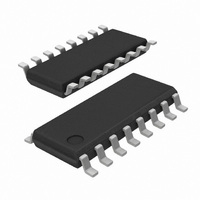SI3010-F-GS Silicon Laboratories Inc, SI3010-F-GS Datasheet - Page 13

SI3010-F-GS
Manufacturer Part Number
SI3010-F-GS
Description
IC ISOMODEM LINE-SIDE 16SOIC
Manufacturer
Silicon Laboratories Inc
Datasheet
1.SI3010-F-GS.pdf
(76 pages)
Specifications of SI3010-F-GS
Data Format
V.92
Interface
Serial
Voltage - Supply
3 V ~ 3.6 V
Mounting Type
Surface Mount
Package / Case
16-SOIC (3.9mm Width)
Lead Free Status / RoHS Status
Lead free / RoHS Compliant
Baud Rates
-
Lead Free Status / RoHS Status
Lead free / RoHS Compliant, Lead free / RoHS Compliant
4.1. Serial Interface
The Si2401 has a universal asynchronous receiver/
transmitter (UART) serial interface compatible with
standard microcontroller serial interfaces. After powerup
or reset, the speed of the serial (Data Terminal
Equipment—DTE) interface is set by default to
2400 bps with the 8-bit, no parity, and one-stop bit (8N1)
format described below.
The serial interface DTE rate can be modified by writing
SE0[2:0] (SD) with the value corresponding to the
desired DTE rate. (See Table 8.) This is accomplished
with the command, ATSE0=xx, where xx is the
hexadecimal value of the SE0 register.
Immediately after the ATSE0=xx string is sent, the host
UART must be reprogrammed to the new DTE rate in
order to communicate with the Si2401.
The carriage return character following the ATSE0=xx
string must be sent at the new DTE rate to observe the
“O” response code. See Table 12 on page 24 for the
response code summary.
4.2. Configurations and Data Rates
The Si2401 can be configured to any of the Bell and
CCITT operation modes listed in Table 9. When
configured for V.22bis, the modem connects at
1200 bps if the far end modem is configured for V.22.
This device also supports SIA and other protocols for
the security industry. Table 7 provides the modulation
method, carrier frequencies, data rate, baud rate, and
notes on standard compliance for each modem
configuration of the Si2401. Table 9 shows example
register settings (S07) for some of the modem
configurations.
DTE Rate (bps)
307200
115200
19200
38400
1200
2400
9600
300
Table 8. DTE Rates
SE0[2:0] (SD)
000
001
010
011
100
101
110
111
Rev. 1.0
As shown in Figure 3, 8-bit and 9-bit data modes refer to
the DTE format over the UART. Line data formats are
configured through registers S07 (MF1) and S15 (MLC).
If the number of bits specified by the format differs from
the number of bits specified by the DCE data
communications equipment or line (DTE) format, the
MSBs are either dropped or bit-stuffed, as appropriate.
For example, if the DTE format is 9 data bits (9N1), and
the line data format is 8 data bits (8N1), the MSB from
the DTE is dropped as the 9-bit word is passed from the
DTE side to the DCE (line) side. In this case, the
dropped ninth bit can then be used as an escape
mechanism. However, if the DTE format is 8N1, and the
line data format is 9N1, an MSB equal to 0 is added to
the 8-bit word as it is passed from the DTE side to the
DCE side.
The Si2401 UART does not continuously check for stop
bits on the incoming digital data. Therefore, if the TXD
pin is not high, the RXD pin may echo meaningless
characters to the host UART. This requires the host
UART to flush its receiver FIFO upon initialization.
Data Format: SE0[3] (ND)
Data Rate: SE0[2:0] (SD)
RXD
TXD
V.23 (1200 tx, 75 rx)
V.23 (75 tx, 1200 rx)
Table 9. Modem Configuration Examples
V.23 (600 tx, 75 rx)
V.23 (75 tx, 600 rx)
Modem Protocol
DTE Interface
Figure 3. Link and Line Data Formats
(S07[7] (HDEN) = 0, S07[6] (BD) = 0)
Bell 212A
Bell 103
V.22bis
V.22
V.21
Si2401
Si3010
DCE (Line) Interface
Register S07 Values
Data Format: S15 (MLC)
Data Rate: S07 (MF1)
0x06
0x02
0x03
0x00
0x01
0x16
0x26
0x10
0x20
Si2401
RJ11
13













